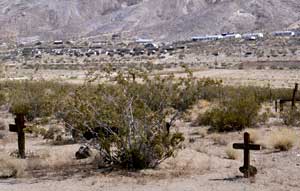|
Somewhere between Lone Pine and
Death Valley, in a hot dusty, remote and desolate area, lies
the mere shadow of a town called Darwin. The first white travelers to pass through the
area were the Death Valley
49'ers coming from Salt Lake City
to the California
goldfields. In 1850, Dr. Erasmus Darwin French
came through on a search for the Lost Gunsight Mine, which was believed
to be in the Panamint
Valley. In 1861 silver ore was discovered ten miles
southeast of Darwin
and the Coso Mining District was formed. October
1870, William Egan, J.C. Watt, and Paul W. Bennett, discovered pure
galena near the springs of Darwin
Canyon. By the 24th of that same month, James Brady
(famous for the steamers he ran across Owens
Lake) joined the three men to organize the Granite
Mountain Mining District. The discoveries went virtually unnoticed at
the time. In the fall of 1874, discoveries made by the Brown Brothers,
William and Robert, were announced in the Inyo Independent newspaper.
Miners and entrepreneurs flocked to the site. The new Coso Mining
District was formed at this time, as well as the town of
Darwin. Erasmus Darwin French, more than likely,
never
visited the town that grew around the area he had traveled through so
many years before.
 |
| The
mines and one-time tourist cabins of Darwin today are as dead as
the occupants of the town's cemetery. |
Typical of mining towns of the era, Darwin
became a rough and tumble town with rich
producing mines, claim battles, gunfights, robberies, etc. It quickly
grew from flimsy canvas hovels to substantial buildings with flourishing
businesses. By February 1875, Darwin boasted a hotel, three restaurants,
two butcher shops, a livery stable, two stores, seven saloons, a drug
store, as well as a doctor's and a lawyer's office. Soon there were two
baseball teams, the Inyos and the Independents. The Wells Fargo office
and post office followed. Victor Beaudry, also of
Cerro Gordo
fame, piped in much needed water. In May of
1876, the Inyo Independent declared Darwin
"the most important mining district and
largest town" of Inyo county. Colonel Sherman Stevens began
building a tramway from Darwin
to the shore of Owens
Lake
to transport the massive bullion production. The
town population soared to 3,500 people by 1877. More than 226,672 ounces
of silver and 1,920,261 pounds of lead were recovered from the mines.
Off to Bodie
July of 1878, news
of rich discoveries in the Bodie Hills sent miners and businessmen
flying north where prospects suddenly looked better. Coso Mining News
editor T. S. Harris loaded up his press and moved with them. His first
issue of the Bodie Standard declared he "would not make the trip of
190 miles again for all the unoccupied houses and deserted mines of Darwin." Darwin's population dwindled to 300 people. Fire, the
fear of all desolate towns, destroyed 15 major buildings in April 1879.
June of 1880, the population was reduced to 80. By 1882, congressman
Samuel D. Woods passed through town and declared, "it seems as yet
impossible that it could be a town where humans lived... There could be
no living in the higher sense in a place so devoid of everything that
makes life even physically endurable. The principal business place of
the town was a saloon. No hotel was visible and we were compelled to
take our breakfast at a little restraint." Renewed prospect
interests during the first and second World Wars sparked some hope for
the town--only to be short lived.
For a time between 1920-1937, Darwin
attracted attention to the world once again. H.
W. "Bob" Eichbaum built the Death Valley Toll Road, and his wife built a resort at the end of the
road in Stovepipe Wells. Darwin
became known as the " Gateway to
Death Valley." Alas, in 1937, Highway 190 was
built
re-routing the traffic and the tourist trade, and Lone Pine got the
honor. Darwin's fate was written in the sand.
Today Darwin
appears more ghostly than most ghost towns. The
ramshackle buildings and old trailers that house Darwinís few residents seem to have eyes peering from
their darkened windows. A stop to the old miners' dugouts on the way to
the cemetery may surprise you with a Darwinite spending his summer there
to keep cool. The cemetery itself is truly haunting. Everyone should go
to
Darwin
at least once in their lifetime. Darwin
is a town truly in a class all of its own.
Bibliography
Darwin,
California
by
Robert
P. Palazzo
Western
Places
Death Valley
& The Amargosa, A
Land
of
Illusion
by
Richard
E. Lingenfelter
University
of
California
Press
http://members.aol.com/dierdorff/darwin/index.html
|

